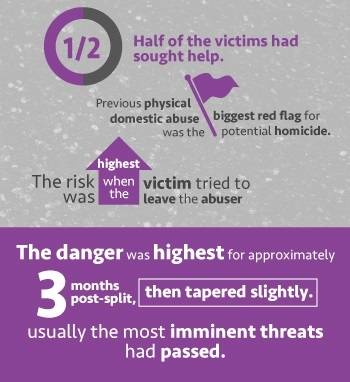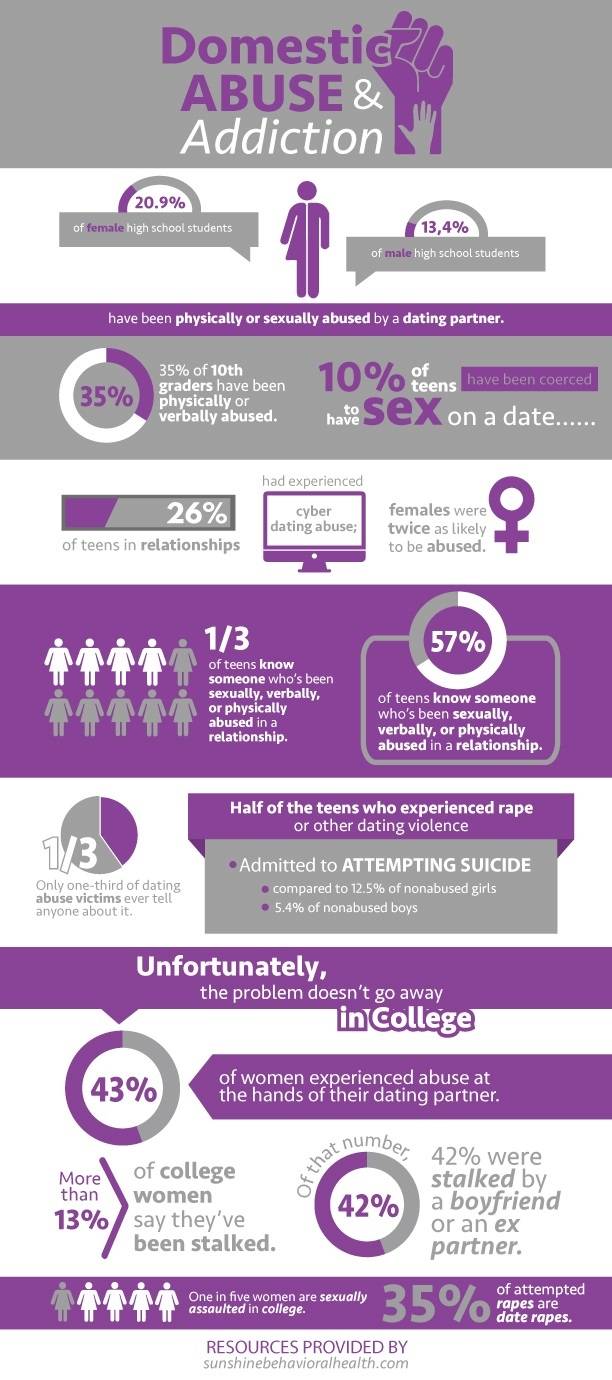History is full of stories of intimate partner violence.
In ancient Rome, men had life and death power over wives. Today, we may be more aware of social injustices, but domestic violence remains problematic. More than 12 million women and men are victims of rape, physical violence, or stalking every year in the United States. More than one-third of women and one-fourth of men have been raped, assaulted, or stalked by an intimate partner.
Such problems have never gone away despite activism and legislation like the Violence Against Women Act, but there are several women’s rehabilitation programs emerging all over the United States that are designed to prevent, protect, and educate.
Note: There is a strong correlation between Domestic Violence and addiction. If you or a loved one are battling addiction, we are here for you. We’ve helped individuals recover from alcohol addiction, meth addiction, heroin addiction, cocaine addiction, and more. Sunshine Behavioral Health has inpatient drug addiction rehab locations in Texas, Colorado, California and Illinois.
Domestic Violence Defined
 Domestic violence is far more than simply being pushed around. Abuse comes in many forms and can affect anyone. Types of violence include:
Domestic violence is far more than simply being pushed around. Abuse comes in many forms and can affect anyone. Types of violence include:
- Physical: pushing, kicking, shoving, hitting, strangling
- Verbal or emotional: threats, humiliation, insults, intimidation, monitoring, social isolation
- Sexual: sexual abuse, rape, genital mutilation, harassment, overseeing birth control
Abuse can take a number of forms. Technology or social media can be used to harass, threaten, stalk, or monitor a current or former partner.
Stalking can be done in real life, too, by following someone’s activities or leaving unwelcome gifts. Abuse can be economic as well, in that one partner controls the finances, or withholds or takes money, or keeps the other partner from working.
Some sources bring up symbolic violence as well, where the media or culture either perpetuate or normalize brutality, in particular against women.
While this problem is far from solved, in recent years new tactics are being implemented to try to put a stop to intimate partner violence.
Domestic Violence High Risk Teams
One promising approach toward curbing domestic violence deaths poses the question: What if you could predict which victims were in the most danger?
That’s what’s at the heart of Domestic Violence High Risk Teams. These task forces operate on the local level, where area shelters work with law enforcement entities and the courts. They work to identify and protect the people at most risk by helping various participants communicate with one another.
Kelly Dunne and Suzanne Dubus are the chief of operations and the chief executive officer of the Jeanne Geiger Crisis Center in Massachusetts. Dunne and Dubus formed the first DVHRT in 2005 after Dunne was inspired by a conference she attended in 2003.
Jacquelyn Campbell, a professor at Johns Hopkins University School of Nursing and a leading expert on domestic homicide, was a speaker at that conference. For her doctorate, Campbell interviewed 2,000 domestic violence survivors and combed through homicide files, searching for patterns.
Some of Campbell’s findings include:
- Half of the victims had sought help.
- Previous physical domestic abuse was the biggest red flag for potential homicide.
- The risk was highest when the victim tried to leave the abuser, or when there was some other significant change brewing at home — a pregnancy, for example.
- The danger was highest for approximately three months post-split, then tapered slightly. After a year, usually the most imminent threats had passed.
Campbell’s work led her to create a Danger Assessment tool, a list of 20 potential risk factors for homicide. It includes substance use disorder, gun ownership, a history of violence, and threats to kill.
The higher the Danger Assessment score, the greater the danger. The DVHRT Model operates on the principle that most intimate partner homicides are predictable and therefore preventable.
Risk assessments are folded into a local community’s domestic violence response system to identify the most urgent cases. The domestic violence agency then partners with law enforcement and the courts while finding alternatives to a shelter (private accommodations or safe homes). Instead of all components operating independently of one another, the task force fills communication gaps and keeps information flowing.
DVHRTs are still relatively new, but they appear to work. There are more than 100 communities in Massachusetts who have adopted them. They’ve also been established in California, Texas, Ohio, and New York, among other places.
 In its first 12 years, the Jeanne Geiger Crisis Center handled 172 high-risk cases. The results were highly promising, including:
In its first 12 years, the Jeanne Geiger Crisis Center handled 172 high-risk cases. The results were highly promising, including:
- Zero homicides
- 95% of victims stayed in their communities, as opposed to entering shelters
- 90% reported no further assaults
To start a DVHRT, core partner organizations must be on board, and a community assessment must be performed. Each task force is designed to fit the area’s jurisdiction, and training, implementation, and evaluations follow. More information about creating a DVHRT can be found here.
Teen Dating Violence 101
Teens are slowly — and sometimes not so slowly — dipping their toes into the world of adult concerns.
One of those grown-up issues is dating and the violence that sometimes comes along with it.
The National Coalition Against Domestic Violence shares some disturbing data:
- 20.9% of female high school students and 13.4% of male high school students have been physically or sexually abused by a dating partner.
- 35% of 10th graders have been physically or verbally abused.
- 10% of teens have been coerced to have sex on a date.
- 26% of teens in relationships had experienced cyber dating abuse; females were twice as likely to be abused.
- 57% of teens know someone who’s been sexually, verbally, or physically abused in a relationship.
- Only one-third of dating abuse victims ever tell anyone about it.
- Half of the teens who experienced rape or other dating violence admitted to attempting suicide (compared to 12.5% of nonabused girls and 5.4% of nonabused boys).
Unfortunately, the problem doesn’t go away in college:
- 43% of women experienced abuse at the hands of their dating partner.
- More than 13% of college women say they’ve been stalked. Of that number, 42% were stalked by a boyfriend or an ex partner.
- One in five women are sexually assaulted in college.
- 35% of attempted rapes are date rapes.

Stopping Teen Dating Violence
Domestic violence occurs most often among women between the ages of 18 to 24. To stem the tide of abuse, the National Coalition Against Domestic Violence (NCADV) suggests pushing for policy changes and updates. They include:
- Contacting local Congressional representatives and advocating for updates to the federal definition of domestic violence to include dating abuse and stalking.
- Supporting laws and programs that create educational and counseling programs to better identify and prevent domestic violence.
- Increasing funds for programs related to the Violence Against Women Act (VAWA).
The NCADV also offers a kind of streamlined Civics 101 course. The course educates people on how to promote antiviolence legislation, gives information about people and organizations to contact, and provides more information.
Early Prevention is Key
According to the American Journal of Preventive Medicine, early prevention lowers the likelihood of dating violence.
The Centers for Disease Control and Prevention developed the Dating Matters program, which describes the characteristics of healthy and unhealthy teen relationships, shares statistics and examples of dating violence as well as red flags, and shows how to foster good connections and preveThe way teens date and experience relationships differs from adults. More teens experience abuse via or over social media, typically over posts and passwords.
Abusers resort to messenger and locator apps to monitor their partners’ whereabouts. Because some people — especially young people — practically live online, it’s all the harder to avoid an abusive partner if they constantly message or post about the victim.
Addressing why some kids stay in bad relationships is worth noting too. Some rationalize bad behaviors as signs of love; others stick around because their partner boosts their social status.
Signs of abuse include:
- Isolation
- Unexplained or unusual injuries
- A lack of interest in once-enjoyed activities
- Excuses for a partner’s bad behavior
It’s not just boy-girl problems, either; abuse happens in the LGBTQ community as well.
A Potentially Explosive Cocktail
Drugs and alcohol, when mixed with hormones and extreme emotions, do not make for a good cocktail at any age.Alcohol and drugs can make emotions harder to control, interfere with decision-making, and fuel impulsive behaviors.
Teens under the influence are more prone to jealousy, controlling behaviors, physical abuse, emotional abuse, and sexual abuse.Victims of dating violence in turn are at greater risk for using drugs and alcohol to cope with abuse.
Programs to Stop the Cycle
Because violent relationships during the adolescent years can lead to other dangerous behaviors such as substance use disorder, risky sexual activities, or more domestic violence later in life, programs are popping up nationwide to help put an end to abusive behaviors. Here’s a small sampling:
- Alliance for HOPE International is a social change organization that works to create programs and strategies to do away with domestic violence, sexual assault, child abuse, and more.
- The Family Justice Center Alliance serves as a clearinghouse, research hub, and national affiliation organization to help communities worldwide develop their own family justice centers or similar models designed to help victims of domestic abuse.
- The Justice Legal Network provides legal support to victims while helping attorneys build their own practices as they do pro bono casework for victims.
- The Training Institute on Strangulation Prevention aims to crack down on strangulation crimes and helps medical professionals and law enforcement better identify cases where the victim may have been choked.
- The Camp HOPE America program offers camping and mentoring opportunities for children of domestic violence situations.
- A new YWCA program called GameChangers, based in eastern Tennessee, is designed to teach young men about sexual assault, domestic abuse, and consent, as well as how to step in when they witness it. The goal is to protect and respect via knowledge and awareness while fighting negative gender stereotypes.
- WomenShelter of Long Beach hosted a half-day conference — Getting the Conversation Started — that teaches teens how to spot the warning signs of bad hookups and shows them how to remove themselves from such relationships.
Consider Texting for Help
In the heat of the moment it may be riskier to make a phone call and speak to a 911 operator, so texting may be safer. Some communities advise doing that, including after an assault (especially when the perpetrator is nearby).
Not all communities have this option, but for ones that do, victims can text 911 and ask for help. Text assistance differs from voice call assistance in that text messages do not display locations on dispatchers’ monitors. A simple and clear text mentioning the location is advised.
The Federal Communications Commission (FCC) has a regularly updated list of areas that offer text-to-911 services. FCC regulations also require wireless carriers and other text messaging apps to deliver emergency texts to call centers that ask for them. If a call center requests text-to-911, the text message provider must implement the service within six months.
In some cases, victims have dialed 911 and instead of asking for help, they’ll ask for a pepperoni pizza. They do this because they don’t want their abusers to know that they’re calling and they fear possible retaliation from them.
Some emergency personnel, like in the Salt Lake City area, have been trained to treat such calls as potential calls for help. Operators can ask a few pointed questions that require only “yes” or “no” answers and dispatch help as needed.
Millions of people are victims of domestic violence every year. It is a crime that does not discriminate: young, old, white, black, wealthy, poor, men, women, members of the LGBTQ community– it affects all walks of life.
What these individuals have in common is abuse. The bruises may fade and the scars may heal — if the survivor is lucky — but many suffer poor health as a result of violence.
It may manifest as post-traumatic stress disorder (PTSD), in resorting to drug and alcohol abuse, in broken bones, in sexual assault, in unwanted or unplanned pregnancies, or as sexually transmitted diseases. It also may result in loss of life.
Survivors are rarely the only ones affected, either. Families bear lasting wounds. Community resources are taxed when police, courts, and counselors devote endless hours to a recurring and ruthless problem.
To search for a shelter near you, visit DomesticShelters.org. The National Domestic Violence Hotline – Hotline: 800a799aSAFE (7233) National Suicide Prevention Hotline – Crisis hotline: 800a273aTALK (8255); 888a628a9454 (en español) Crisis Text Line – Text 741741 to speak with a trained Crisis Counselor. The Trevor Project – Crisis hotline: 866a488a7386 (for those ages 13-24) National Sexual Assault Hotline –Crisis hotline: 800a656aHOPE (4673) Communities Against Hate – Report an incident. Get help at: 1a844a9aNOaHATE National Alliance on Mental Illness (NAMI) – Helpline: 800a950a6264 Substance Use Disorder and Mental Health Services Administration – Hotline: 800a662aHELP (4357) Domestic Shelters – DomesticShelters.org National Coalition of AntiViolence Programs (NCAVP) – https://avp.org/
Support Hotlines & Hate Incidents
Insurance & Mental Health Resources
Domestic Violence/Abuse Resources
Sources
Medical disclaimer:
Sunshine Behavioral Health strives to help people who are facing substance abuse, addiction, mental health disorders, or a combination of these conditions. It does this by providing compassionate care and evidence-based content that addresses health, treatment, and recovery.
Licensed medical professionals review material we publish on our site. The material is not a substitute for qualified medical diagnoses, treatment, or advice. It should not be used to replace the suggestions of your personal physician or other health care professionals.







